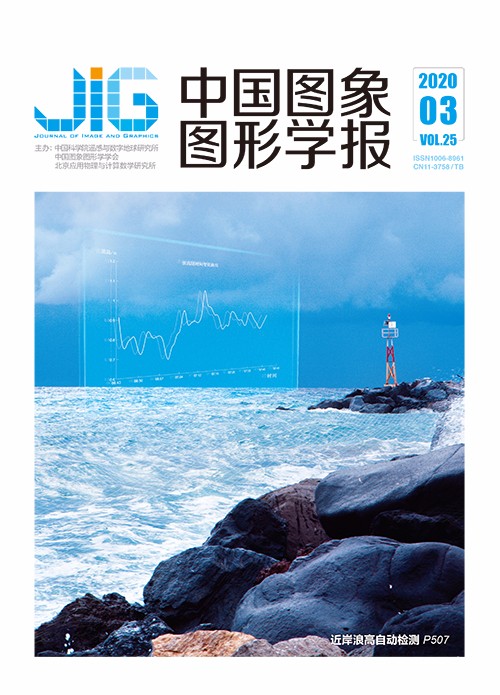
自适应权重注入机制遥感图像融合
方帅1,2, 潮蕾1, 曹风云3(1.合肥工业大学计算机与信息学院, 合肥 230601;2.工业安全与应急技术安徽省重点实验室, 合肥 230601;3.合肥师范学院计算机学院, 合肥 230601) 摘 要
目的 遥感图像融合是将一幅高空间分辨率的全色图像和对应场景的低空间分辨率的多光谱图像,融合成一幅在光谱和空间两方面都具有高分辨率的多光谱图像。为了使融合结果在保持较高空间分辨率的同时减轻光谱失真现象,提出了自适应的权重注入机制,并针对上采样图像降质使先验信息变得不精确的问题,提出了通道梯度约束和光谱关系校正约束。方法 使用变分法处理遥感图像融合问题。考虑传感器的物理特性,使用自适应的权重注入机制向多光谱图像各波段注入不同的空间信息,以处理多光谱图像波段间的差异,避免向多光谱图像中注入过多的空间信息导致光谱失真。考虑到上采样的图像是降质的,采用局部光谱一致性约束和通道梯度约束作为先验信息的约束,基于图像退化模型,使用光谱关系校正约束更精确地保持融合结果的波段间关系。结果 在Geoeye和Pleiades卫星数据上同6种表现优异的算法进行对比实验,本文提出的模型在2个卫星数据上除了相关系数CC(correlation coefficient)和光谱角映射SAM(spectral angle mapper)评价指标表现不够稳定,偶尔为次优值外,在相对全局误差ERGAS(erreur relative globale adimensionnelle de synthèse)、峰值信噪比PSNR(peak signal-to-noise ratio)、相对平均光谱误差RASE(relative average spectral error)、均方根误差RMSE(root mean squared error)、光谱信息散度SID(spectral information divergence)等评价指标上均为最优值。结论 本文模型与对比算法相比,在空间分辨率提升和光谱保持方面都取得了良好效果。
关键词
New pan-sharpening method based on adaptive weight mechanism
Fang Shuai1,2, Chao Lei1, Cao Fengyun3(1.School of Computer and Information, Hefei University of Technology, Hefei 230601, China;2.Anhui Province Key Laboratory of Industry Safety and Emergency Technology, Hefei 230601, China;3.School of Computer Science and Technology, Hefei Normal University, Hefei 230601, China) Abstract
Objective In remote sensing image processing, pan-sharpening is used to obtain a multispectral image spatially and spectrally with a high resolution by merging an original multispectral image with low spatial resolution and a panchromatic image with a high spatial resolution of the corresponding scene. Pan-sharpening has been widely used as a pre-processing tool in various vision applications, including change detection, object recognition, military intelligence, medical assistance, and disaster monitoring. Traditional pan-sharpening methods are mainly divided into two:component substitution (CS) and multire solution analysis (MRA). The fusion result of the CS method has high spatial resolution but easily generates spectral distortion. The MRA method can efficiently maintain spectral information but generates spatial degradation. To improve the spatial resolution of the fusion result while reducing spectral distortion, we use a variational approach based on several assumptions. In general, the difference among bands in multispectral images is rarely considered in the variational method, resulting in the same spatial information injected into each band to cause spectral distortion. Thus, different spatial information must be injected for each band to reduce spectral distortion. Most previous studies have used upsampled images as prior knowledge, but distortion will occur when the image is upsampled. To use the original multispectral image further accurately, we use prior knowledge. The degradation process is added to the method to maintain the spectral relationship among bands further because of the degradation of the upsampled image. Method A new pan-sharpening algorithm based on variational method is built. Given the differences between the MS bands, injecting the same spatial information for each band is unsuitable. To avoid spectral distortion and over sharpening caused by injecting excessive spatial information into multispectral images, we use spatial information constraints based on adaptive weights to inject different spatial information into each band. For the degradation problem of upsampled multispectral images, we use the information of the original and upsampled multispectral images in the model in different ways. First, the original multispectral image is used as a priori knowledge to maintain the spectral information by using channel gradient and local spectral consistency constraints. Second, the introduction of inaccurate inter-band relationship is avoided to reduce the accuracy of the fusion result. By considering the degradation process into the model, the spectral relationship correction constraint is used to restrain the fused result after the degradation for maintaining the relative relationship among the bands of the original multispectral image. The gradient descent algorithm is used to solve the objective function, and a numerical solution framework is designed to obtain the fused result. All experiments are implemented in MATLAB 2017 and executed on a computer with an Intel (R) 3.6 GHz central processing unit and 32 GB memory. Result We compare the proposed model with six state-of-the-art pan-sharpening algorithms, including wavelet, Gaussian low-pass full-scale regression-based approaches, joint intensity-hue-saturation and variational method, variational model for P + XS image fusion, guided filter, and nonlinear intensity-hue-saturation method. The quantitative evaluation metrics contain correlation coefficient (CC), erreur relative globale adimensionnelle de synthèse (ERGAS), root mean squared error (RMSE), peak signal-to-noise ratio (PSNR), spectral angle mapper (SAM), relative average spectral error (RASE), and spectral information divergence (SID). To show the validity of the model, we perform four sets of experiments for comparison. Experimental results show that our model outperforms all other methods in the Geoeye and Pleiades datasets, except in SAM and CC. Comparative experiments demonstrate that the fusion algorithm improves spatial resolution while reducing spectral distortion. In comparison with the suboptimal of all comparison algorithms in Pleiades dataset, average CC and PSNR (the higher the value, the better) increased by 0.74% and 1.85%, respectively; average ERGAS, RASE, RMSE, and SID (the lesser the value, the better) decreased by 8.27%, 6.71%, 6.57%, and 8.07%, respectively. In comparison with the suboptimal of all comparison algorithms in Geoeye dataset, the PSNR increased by an average of 1.16%, and average ERGAS, RASE, RMSE, SAM, and SID decreased by 8.84%, 3.90%, 4.17%, 5.83%, and 15.81%, respectively. Conclusion In this paper, we propose a new pan-sharpening model based on adaptive weight mechanism. Geoeye and Pleiades data are used as test data, and the model is compared with six excellent algorithms. Experiment results show that our model outperforms the six state-of-the-art pan-sharpening approaches and improves high spatial resolution while mitigating spectral distortion.
Keywords
remote sensing image fusion multi-spectral image variational method adaptive weights channel gradient constraints spectral correlation correction constraint
|



 中国图象图形学报 │ 京ICP备05080539号-4 │ 本系统由
中国图象图形学报 │ 京ICP备05080539号-4 │ 本系统由